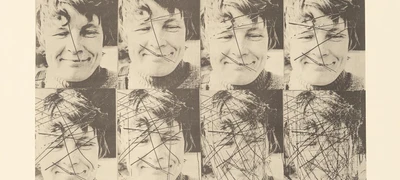Making Public: 40 Artists from the Collection of the Centre for Art Exhibitions of the GDR

The compilation of 40 artists from the collection of the GDR Centre for Art Exhibitions presented here outlines continuities and ruptures as well as influences and relationships that make it clear that artists in the GDR not only worked in accordance with the system or conformed to it, but also found their place in the in-between against the odds. The exhibition shows that art was networked and connected in attitudes and genres both within the country and beyond its borders.
40 Artists
4 Contributors
Susanne Weiß,
Concept
Susanne Weiß,
Tina Weingardt,
Paulinus Burger,
Project Management ifa
About the exhibiton
With the online exhibition Going Public, the ifa wants to provide a first glimpse into an inventory that comprises circa 10 000 works by 630 artists. The collection of the ZfK (the GDR’s Zentrum für Kunstausstellungen, or the GDR Centre for Art Exhibitions) includes works on paper, such as watercolors, hand drawings in ink or other pigments, graphic prints in the form of lithography or etchings, small-scale sculpture, portfolios, and artist books. Founded in 1973 as an independent institution by the GDR Ministry of Culture, the ZfK employed a staff of circa 80 employees in sections for the fine arts, handicrafts, poster art, and stage design, organizing exhibitions in East Germany and abroad. In developing and carrying out its projects, which were exhibited not only in Socialist “Sister countries,” but also in the so-called “Western foreign countries,” the institution worked closely together with the GDR’s VBK (Verband Bildender Künstler, or Association of Visual Artists). The fall of the Wall brought the work of the ZfK abruptly to an end. With the German Reunification Treaty of 3 October 1990, the cultural foreign policy of the GDR was integrated into the Foreign Service of the FRG and the ZfK was formally liquidated by the GDR Ministry of Culture effective 31 December 1990. It ceded its inventory of graphic works to the ifa and distributed the remainder of its collection to various museums in the former East Germany.
The selection exhibited here spans an arc from early expressionist watercolors by Edmund Kesting, produced in the late 1910s, to concrete constructivist silkscreens by Horst Bartnig from the 1980s. And between the two: 38 other artists, including 11 women, who either played an important role in the margins of the establishment’s art scene or enjoyed widespread success as protagonists of the theatre for official art in that era. The selection also features representatives of the non-conforming art scene in the GDR – those who most chafed and grated against the prevalent doctrine of Socialist Realism. Our anthology points to both continuities and ruptures, to influences and connections, which make evident that artists in the GDR did not work exclusively with faith in and in conformity with the dominant system, but were able, despite resistance, to carve out room for themselves in the in-between space. The exhibition shows that East German artists, in their attitudes and approaches to various media, were interconnected and in communication through a network that extended both across the country and beyond its borders.
The art historians and journalists Anke Paula Böttcher, Sylvie Kürsten, Elke Neumann, Tobias Rosen, Ingeborg Ruthe, and Matthias Zwarg help us understand, with their various textual contributions, the career paths, sources of influence, and contradictions that characterize the work and lives of these artists. They also cast a glance at how artists were affected by the rupture of 1989. Thus, our presentation places biographical or traditional lines of artistic filiation in the foreground and reveals connections between works spanning the period from 1918 to 1988. Beginning with the pioneers of Modernism, some of whom were ostracized and persecuted, the exhibition makes its way through the decades that followed and presents works whose paths of reception, no less than the lives of their authors, were shaped by the ideological and political turbulence of the 20th century.
The majority of the artists represented here – whose works were shown in exhibitions of the ZfK in East Germany and around the world – belonged to an art scene that developed and employed minimalist, abstract, critical-realist, neo-expressionist, and experimental techniques, as well as subversive approaches and methods. The exhibition also includes work, however, that gave preference to realist, figurative, and more popular subjects. Our selection thus demonstrates that art in the GDR, while stemming from common traditions, had a multi-faceted influence on society. It was tied in to trends and styles that transcended any one political system and benefitted from an international network.
This exhibition is a joint project of the ifa-Institut für Auslandsbeziehungen and the Wüstenrot Stiftung and was curated by Susanne Weiß. It is based on the progress of digitalization through 2020, when circa a quarter of the total inventory had been saved to our databank.
The respective work and biographies, which can be found by clicking on the respective work, can be read through the texts of the art historians and journalists: Anke Paula Böttcher, Sylvie Kürsten, Elke Neumann, Tobias Rosen, Ingeborg Ruthe and Matthias Zwarg.